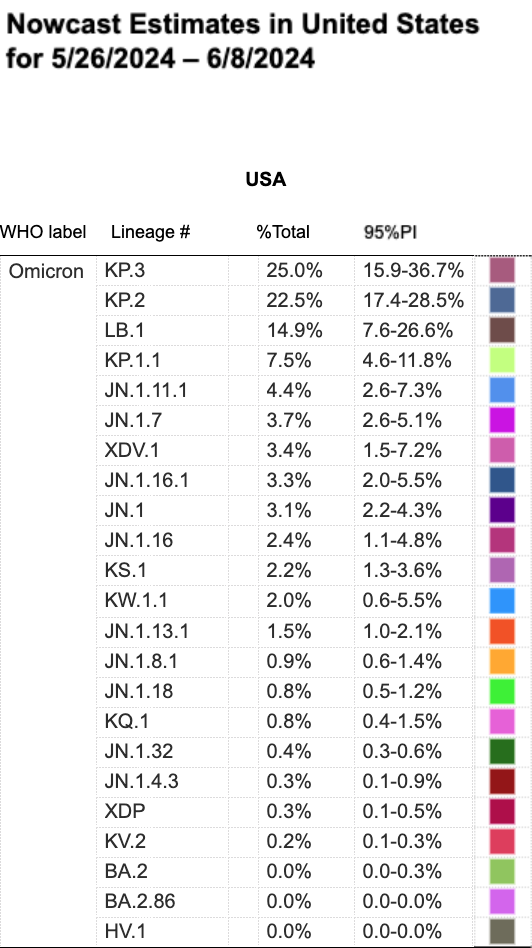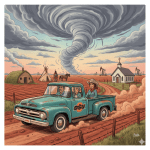I have long subscribed to my “Law of Conservation of Happiness” where good news is balanced by bad news to keep things on an even keel.
We had a great vacation in early June 2024 to southwestern Oregon and the northern coast of California to see the redwoods. A trip that far away meant flying, and the previous time I had flown on a plane, in June 2023 for a conference in Philadelphia, I sat in coach on a return flight by a big guy with an obvious respiratory infection. I had no mask handy, so I endured it and unsurprisingly fell ill and was sick for the following week. It didn’t test as COVID, but it wasn’t fun.
Almost a year later, Wendy and I were flying first class, so I wouldn’t be crammed up against someone who was sick, but of course COVID aerosols could still spread through the plane and the airport restrooms, security checkpoints, and gate areas were high-risk. Since we were visiting more progressive areas of the country, we did see some folks in the airports and hotels, servers at restaurants, etc. who chose to mask up to reduce their risk of infection.

A properly fitted N95, KN95, or KF94 mask is indeed worthwhile if you want to significantly reduce your chance of infection in high-risk environments. If you want all of the nuances about masks, read this.
Anyway, we took our chances, enjoyed our trip, and returned on a Monday night. I felt fine until Wednesday afternoon, when I started getting a stuffy nose and clogged sinuses.
Wednesday night I was feverish and slept quite poorly. On Thursday I took ibuprofen for a headache and body aches, and I began periodic nasal irrigation with my NeilMed Sinus Rinse bottle to clear my sinuses. I had continued thermal regulation issues, stuffy sinuses, both nasal congestion and a runny nose, aches, and fatigue on Thursday and Friday, which I treated with ibuprofen, sinus rinses, pseudoephedrine by day, and diphenhydramine at night. A cough developed on Saturday.
Since on Sunday I was planning to take my 87-year-old mother out for lunch, on Saturday I pulled out one of our remaining COVID tests and ran it, even though it expired in February. In less than a minute, it showed my sample as positive.
There is no reason for an expired test to give a false positive, while a breakdown of its components might give a false negative. So I am confident that I have been infected with COVID for the second time; my first round with it was in November 2022.
So I sure do wish I had masked up throughout our times in the airports and on the planes, although I can’t be certain those environments were where I was infected.
Now what?
The CDC’s COVID infection protocol was originally to isolate for ten days, with quarantines for close contacts. By the time I contracted COVID in November 2022, that had been shortened to five days , if no fever for 24 hours without fever-reducing medications, to be followed by distancing and masking precautions for another five days.
Back in 2022, my isolation overlapped into a week of vacation days. I chose the conservative route, isolating until I no longer tested positive on a rapid test. That was not until 14 days after my symptoms began, and 8 days after first testing positive.
These days, the CDC has simplified its recommendation to be the same for any respiratory illness:

I may or may not be at the Go about normal activities, taking adding precautions phase by Tuesday, six days after my symptoms began. I hope to work remotely, but later in the week I will have to go in to do a few things that require my physical presence. I’ll be wearing a KF94 mask whenever I am around others, and I’ll be running the air purifier in my office at top speed.

The changes in the CDC guidance reflected how the hospitalization and mortality rates for COVID plummeted once vaccines were available, and particularly after the Omicron surge in the winter of 2021-2022. I had received the Pfizer vaccine in February and March 2021 with an October 2021 booster, and a Moderna vaccine in April and October 2022. I had an updated Moderna booster in October 2023.
The virus continues to mutate, so vaccine protection against infection wanes after a few months, while it still defends well against hospitalization and death. Actual infection with COVID usually protects you against reinfection for a few months.
I likely had the Omicron BA.4 or BA.5 variant back in November 2022, and currently the widely circulating variants include KP.3, KP.2, and LB.1. My symptoms this time are slightly less severe than with my first COVID infection, but the experience is another reminder for me of the consequences when I let down my guard in high-risk environments, even when the seasonal infection rate is low.
I’ll be flying again near the end of the month to attend a conference in Denver. My chance of getting reinfected by COVID will be very low for about four months, so I won’t be worried. But I do plan on wearing a KF94 mask while in the airports and on board the planes. And on future trips involving air travel, I plan to do the same. Masking while in those high-risk environments is a minor inconvenience compared to a week or more of unpleasant symptoms from various respiratory infections, including nasty old COVID.



















